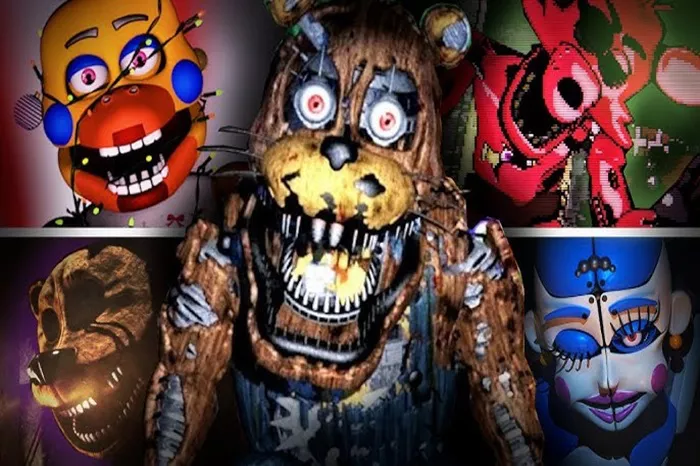Five Nights at Freddy’s (FNaF), a groundbreaking indie horror game series created by Scott Cawthon, has captivated players worldwide since its initial release in 2014. Known for its unique blend of suspense, strategy, and jump scares, FNaF has spawned a thriving franchise encompassing sequels, spin-offs, merchandise, and a dedicated fanbase. This article delves into the fascinating journey of how Five Nights at Freddy’s was conceptualized, developed, and evolved into a cultural phenomenon.
Conceptualization and Early Development
The origins of Five Nights at Freddy’s trace back to Scott Cawthon’s background as a game developer with a passion for creating engaging and immersive experiences. Prior to FNaF, Cawthon had developed several games, primarily in the Christian entertainment market. However, it was his foray into horror gaming that would ultimately define his career.
Inspired by a combination of real-life experiences and childhood fears, Cawthon conceived the idea of a horror game set in a fictional children’s pizza restaurant haunted by animatronic characters. Drawing on elements of suspense and the fear of the unknown, Cawthon envisioned a game where players would assume the role of a night security guard tasked with surviving against these malevolent animatronics.
Development Challenges and Iterations
The development of Five Nights at Freddy’s was marked by iterative design and creative experimentation. Scott Cawthon initially released a demo of the game in August 2014, which garnered attention for its innovative gameplay mechanics and eerie atmosphere. The positive reception encouraged Cawthon to expand the concept into a full-fledged game, refining gameplay elements and enhancing the narrative depth.
Central to FNaF’s development was the strategic use of limited resources and minimalist design. The game’s premise, set within the confines of a security office equipped with surveillance cameras and a limited power supply, created a claustrophobic environment that heightened tension and suspense. Cawthon’s ability to leverage simplicity to evoke fear and anticipation became a hallmark of FNaF’s gameplay experience.
Release and Initial Reception
Five Nights at Freddy’s was officially released for Microsoft Windows on August 8, 2014, with subsequent versions for iOS and Android platforms following shortly after. The game’s unique premise and effective use of jump scares quickly garnered a cult following among horror gaming enthusiasts and YouTubers who shared gameplay experiences online.
The game’s success was propelled by its accessibility, replayability, and ability to evoke genuine fear through psychological horror elements. Players praised FNaF for its innovative approach to survival horror, where strategic thinking and quick reflexes were essential to surviving encounters with the animatronics.
Expansion and Franchise Development
Building upon the success of the original game, Scott Cawthon and his development team at ScottGames expanded the Five Nights at Freddy’s franchise with sequels, prequels, and spin-off titles. Each installment introduced new gameplay mechanics, deeper lore, and expanded narratives that further explored the haunted world of Freddy Fazbear’s Pizza and its eerie animatronic inhabitants.
The franchise’s expansion included collaborations with publishers and distributors to reach broader audiences across various gaming platforms. Spin-off titles such as Freddy Fazbear’s Pizzeria Simulator and Five Nights at Freddy’s: Help Wanted offered players new challenges and experiences while expanding upon the established lore and mythology of the FNaF universe.
See also: 5 WAYS TO PLAY FIVE NIGHTS AT FREDDY’S SECURITY BREACH
Community Engagement and Fan Interaction
A cornerstone of Five Nights at Freddy’s’ success is its dedicated community of fans who actively engage with the franchise through fan art, fanfiction, theories, and online forums. Scott Cawthon fostered direct communication with the fanbase through social media, where he shared development updates, teaser trailers, and insights into the creative process behind each game.
The interactive nature of fan engagement allowed players to feel invested in the franchise’s evolution, influencing future game design choices and narrative directions. Fan theories and speculation about hidden Easter eggs and cryptic messages within the games contributed to the rich tapestry of FNaF’s lore, further enhancing the immersive experience for players.
Impact and Cultural Legacy
Five Nights at Freddy’s has left an indelible mark on the indie gaming scene and popular culture at large. Beyond its commercial success, the franchise has inspired a wave of indie developers to explore horror gaming and storytelling through innovative mechanics and immersive narratives. The success of FNaF demonstrated the potential of indie games to resonate with global audiences and compete alongside major industry releases.
The cultural legacy of Five Nights at Freddy’s extends beyond gaming into merchandise, fan conventions, and adaptations in other media. The franchise’s iconic characters, including Freddy Fazbear, Bonnie the Bunny, Chica the Chicken, and Foxy the Pirate Fox, have become recognizable symbols within gaming and pop culture, spawning a wide range of collectibles and memorabilia.
Conclusion
In conclusion, Five Nights at Freddy’s stands as a testament to Scott Cawthon’s creativity, innovation, and understanding of suspense in gaming. From its humble beginnings as a demo to a multimedia franchise with a global fanbase, FNaF has redefined horror gaming through its minimalist design, compelling storytelling, and interactive community engagement.
As Scott Cawthon continues to explore new avenues for the Five Nights at Freddy’s franchise and its characters, the legacy of Freddy Fazbear’s Pizza and its haunted animatronics continues to resonate with fans of horror, suspense, and immersive storytelling. Five Nights at Freddy’s exemplifies the power of indie game development to captivate audiences and inspire creativity within the gaming industry, ensuring its place in gaming history for years to come.
Related topics:
TOP 10 CHARACTERS IN FIVE NIGHTS AT FREDDY
FIVE NIGHTS AT FREDDY’S MARKS DECADE WITH RETRO SHIFT IN NEW GAME RELEASE
THE SOUL OF MIKE’S BROTHER IN BALLOON BOY – FIVE NIGHTS AT FREDDY’S THEORY EXPLORED

